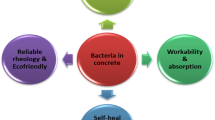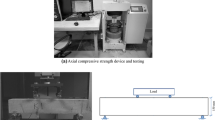Abstract
More eco-friendly and green concretes are needed to lower the climatic and environmental impacts of the growing demand for concrete. Despite the growing interest in using natural zeolite (NZ) in cement-based materials as an eco-friendly alternative for ordinary Portland cement (OPC), there is limited knowledge regarding the post-fire mechanical properties of natural zeolitic concrete (NZC). Hence, the development of a global model is desired to better explore the strength behavior of NZC after exposure to elevated temperatures. This study focused on the post-fire behavior of low-to-high-strength NZC specimens using a novel evolutionary method. Therefore, a widespread experimental program was designed to perfectly investigate the post-fire compressive strength of NZC. The experimental results were then used to develop an evolutionary-based machine learning (ML) model. To do so, the multivariate adaptive regression splines (MARS) method was hybridized with a new metaheuristic algorithm, the Horse herd Optimization Algorithm (HOA). Besides, the results of five different ML models, namely standalone MARS, M5P model tree (M5P), extreme learning machine (ELM), Gaussian process regression (GPR), and gene expression programming (GEP) were employed for comparison with the performance of metaheuristic-based MARS (Meta-MARS) model. Further external validation was conducted to show the superior performance of the Meta-MARS model. Also, a parametric study was conducted to demonstrate the robustness of the developed model. Moreover, an uncertainty analysis inspired by the Monte Carlo simulation (MCS) method was applied to the prediction results. Results of the modeling provided new insight into the post-fire behavior of NZC and agreed well with the experimental results. The satisfactory post-fire performance of NZC is promising and shows the climatic, environmental, and economic advantages of utilizing natural pozzolans.


















Similar content being viewed by others
References
NoParast M, Hematian M, Ashrafian A, Amiri MJT, AzariJafari H. Development of a non-dominated sorting genetic algorithm for implementing circular economy strategies in the concrete industry. Sustain Prod Consum. 2021;27:933–46.
Shahmansouri AA, Yazdani M, Hosseini M, Bengar HA, Ghatte HF. The prediction analysis of compressive strength and electrical resistivity of environmentally friendly concrete incorporating natural zeolite using artificial neural network. Constr Build Mater. 2022;317: 125876.
Shahmansouri AA, Bengar HA, AzariJafari H. Life cycle assessment of eco-friendly concrete mixtures incorporating natural zeolite in sulfate-aggressive environment. Constr Build Mater. 2021;268: 121136.
Najimi M, Sobhani J, Ahmadi B, Shekarchi M. An experimental study on durability properties of concrete containing zeolite as a highly reactive natural pozzolan. Constr Build Mater. 2012;35:1023–33.
Ahmadi B, Shekarchi M. Use of natural zeolite as a supplementary cementitious material. Cem Concr Compos. 2010;32(2):134–41.
Vejmelková E, Koňáková D, Kulovana T, Keppert M, Žumár J, Rovnaníková P, Keršner Z, Sedlmajer M, Černý R. Engineering properties of concrete containing natural zeolite as supplementary cementitious material: strength, toughness, durability, and hygrothermal performance. Cem Concr Compos. 2015;55:259–67.
Markiv T, Sobol K, Franus M, Franus W. Mechanical and durability properties of concretes incorporating natural zeolite. Arch Civ Mech Eng. 2016;16:554–62.
Tran YT, Lee J, Kumar P, Kim K-H, Lee SS. Natural zeolite and its application in concrete composite production. Compos B Eng. 2019;165:354–64.
Valipour M, Yekkalar M, Shekarchi M, Panahi S. Environmental assessment of green concrete containing natural zeolite on the global warming index in marine environments. J Clean Prod. 2014;65:418–23.
Novak J, Kohoutkova A. Mechanical properties of concrete composites subject to elevated temperature. Fire Saf J. 2018;95:66–76.
Botte W, Caspeele R. Post-cooling properties of concrete exposed to fire. Fire Saf J. 2017;92:142–50.
Bengar HA, Shahmansouri AA. Post-fire behavior of unconfined and steel tube confined rubberized concrete under axial compression. Structures. 2021;32:731–45.
Husem M. The effects of high temperature on compressive and flexural strengths of ordinary and high-performance concrete. Fire Saf J. 2006;41(2):155–63.
Heap M, Lavallée Y, Laumann A, Hess K-U, Meredith P, Dingwell DB, Huismann S, Weise F. The influence of thermal-stressing (up to 1000 C) on the physical, mechanical, and chemical properties of siliceous-aggregate, high-strength concrete. Constr Build Mater. 2013;42:248–65.
Karakurt C, Topçu İB. Effect of blended cements with natural zeolite and industrial by-products on rebar corrosion and high temperature resistance of concrete. Constr Build Mater. 2012;35:906–11.
Akçaözoğlu K, Fener M, Akçaözoğlu S, Öcal R. Microstructural examination of the effect of elevated temperature on the concrete containing clinoptilolite. Constr Build Mater. 2014;72:316–25.
Beycioglu A, Aruntaş HY, Gencel O, Lobland HEH, Şamandar A, Brostow W. Effect of elevated temperatures on properties of blended cements with clinoptilolite. Mater Sci. 2016;22(4):548–52.
AzariJafari H, Amiri MJT, Ashrafian A, Rasekh H, Barforooshi MJ, Berenjian J. Ternary blended cement: an eco-friendly alternative to improve resistivity of high-performance self-consolidating concrete against elevated temperature. J Clean Prod. 2019;223:575–86.
Moghadam MA, Izadifard RA. Experimental investigation on the effect of silica fume and zeolite on mechanical and durability properties of concrete at high temperatures. SN Appl Sci. 2019;1(7):1–11.
Kushnir AR, Heap MJ, Griffiths L, Wadsworth FB, Langella A, Baud P, Reuschlé T, Kendrick JE, Utley JE. The fire resistance of high-strength concrete containing natural zeolites. Cem Concr Compos. 2021;116: 103897.
Behnood A, Golafshani EM. Artificial intelligence to model the performance of concrete mixtures and elements: A review. Arch Comput Methods Eng. 2021;1–24.
Asteris PG, Skentou AD, Bardhan A, Samui P, Pilakoutas K. Predicting concrete compressive strength using hybrid ensembling of surrogate machine learning models. Cem Concr Res. 2021;145: 106449.
Golafshani EM, Behnood A. Predicting the mechanical properties of sustainable concrete containing waste foundry sand using multi-objective ANN approach. Constr Build Mater. 2021;291: 123314.
Ren Q, Ding L, Dai X, Jiang Z, De Schutter G. Prediction of compressive strength of concrete with manufactured sand by ensemble classification and regression tree method. J Mater Civ Eng. 2021;33(7):04021135.
Feng D-C, Liu Z-T, Wang X-D, Chen Y, Chang J-Q, Wei D-F, Jiang Z-M. Machine learning-based compressive strength prediction for concrete: an adaptive boosting approach. Constr Build Mater. 2020;230: 117000.
Liu Q-F, Iqbal MF, Yang J, Lu X-Y, Zhang P, Rauf M. Prediction of chloride diffusivity in concrete using artificial neural network: modelling and performance evaluation. Constr Build Mater. 2021;268: 121082.
Amlashi AT, Abdollahi SM, Goodarzi S, Ghanizadeh AR. Soft computing based formulations for slump, compressive strength, and elastic modulus of bentonite plastic concrete. J Clean Prod. 2019;230:1197–216.
Zhang J, Li D, Wang Y. Toward intelligent construction: prediction of mechanical properties of manufactured-sand concrete using tree-based models. J Clean Prod. 2020;258: 120665.
Ganesh AC, Muthukannan M. Development of high performance sustainable optimized fiber reinforced geopolymer concrete and prediction of compressive strength. J Clean Prod. 2021;282: 124543.
Jalal M, Grasley Z, Gurganus C, Bullard JW. Experimental investigation and comparative machine-learning prediction of strength behavior of optimized recycled rubber concrete. Constr Build Mater. 2020;256: 119478.
Ashrafian A, Amiri MJT, Masoumi P, Asadi-shiadeh M, Yaghoubi-chenari M, Mosavi A, Nabipour N. Classification-based regression models for prediction of the mechanical properties of roller-compacted concrete pavement. Appl Sci. 2020;10(11):3707.
Chen S, Zhao Y, Bie Y. The prediction analysis of properties of recycled aggregate permeable concrete based on back-propagation neural network. J Clean Prod. 2020;276: 124187.
Naderpour H, Mirrashid M. Estimating the compressive strength of eco-friendly concrete incorporating recycled coarse aggregate using neuro-fuzzy approach. J Clean Prod. 2020;265: 121886.
Shahmansouri AA, Bengar HA, Jahani E. Predicting compressive strength and electrical resistivity of eco-friendly concrete containing natural zeolite via GEP algorithm. Constr Build Mater. 2019;229: 116883.
Elrahman MA, Sikora P, Chung S-Y, Stephan D. The performance of ultra-lightweight foamed concrete incorporating nanosilica. Arch Civ Mech Eng. 2021;21(2):79.
ASTM. C305-14: standard practice for mechanical mixing of hydraulic cement pastes and mortars of plastic consistency. ASTM International; 2014.
Standard B. 1881 Part-116 method for determination of compressive strength of concrete cubes. London: British Standard Institution; 1983.
Poon C, Lam L, Kou S, Lin Z. A study on the hydration rate of natural zeolite blended cement pastes. Constr Build Mater. 1999;13(8):427–32.
Ranjbar MM, Madandoust R, Mousavi SY, Yosefi S. Effects of natural zeolite on the fresh and hardened properties of self-compacted concrete. Constr Build Mater. 2013;47:806–13.
Valipour M, Pargar F, Shekarchi M, Khani S. Comparing a natural pozzolan, zeolite, to metakaolin and silica fume in terms of their effect on the durability characteristics of concrete: a laboratory study. Constr Build Mater. 2013;41:879–88.
Chan SY, Ji X. Comparative study of the initial surface absorption and chloride diffusion of high performance zeolite, silica fume and PFA concretes. Cem Concr Compos. 1999;21(4):293–300.
Huang G-B, Zhu Q-Y, Siew C-K. Extreme learning machine: theory and applications. Neurocomputing. 2006;70(1–3):489–501.
Ferreira C. Gene expression programming: a new adaptive algorithm for solving problems. arXiv preprint cs/0102027. 2001
Rasmussen CE. Evaluation of Gaussian processes and other methods for non-linear regression. University of Toronto Toronto; 1997.
Williams CK, Barber D. Bayesian classification with Gaussian processes. IEEE Trans Pattern Anal Mach Intell. 1998;20(12):1342–51.
Rasmussen CE. Gaussian processes in machine learning, Summer school on machine learning. Springer; 2003. p. 63–71.
Quinlan JR. Learning with continuous classes. In: 5th Australian joint conference on artificial intelligence, World Scientific, 1992, pp. 343–348
Rezaie-Balf M, Maleki N, Kim S, Ashrafian A, Babaie-Miri F, Kim NW, Chung I-M, Alaghmand S. Forecasting daily solar radiation using CEEMDAN decomposition-based MARS model trained by crow search algorithm. Energies. 2019;12(8):1416.
Friedman JH. Multivariate adaptive regression splines. The annals of statistics. 1991;19(1):1–67.
Hastie T, Tibshirani R, Friedman J. Overview of supervised learning, the elements of statistical learning. Springer; 2009. p. 9–41.
Ashrafian A, Shokri F, Amiri MJT, Yaseen ZM, Rezaie-Balf M. Compressive strength of foamed cellular lightweight concrete simulation: new development of hybrid artificial intelligence model. Constr Build Mater. 2020;230: 117048.
MiarNaeimi F, Azizyan G, Rashki M. Horse herd optimization algorithm: a nature-inspired algorithm for high-dimensional optimization problems. Knowl Based Syst. 2021;213: 106711.
Pham BT, Nguyen-Thoi T, Ly H-B, Nguyen MD, Al-Ansari N, Tran V-Q, Le T-T. Extreme learning machine based prediction of soil shear strength: a sensitivity analysis using Monte Carlo simulations and feature backward elimination. Sustainability. 2020;12(6):2339.
Tropsha A. Best practices for QSAR model development, validation, and exploitation. Mol Inf. 2010;29(6–7):476–88.
Ashrafian A, Gandomi AH, Rezaie-Balf M, Emadi M. An evolutionary approach to formulate the compressive strength of roller compacted concrete pavement. Measurement. 2020;152: 107309.
Memarzadeh A, Shahmansouri AA, Nematzadeh M, Gholampour A. A review on fire resistance of steel-concrete composite slim-floor beams. Steel Compos Struct. 2021;40(1):13–32.
Binder K, Ceperley DM, Hansen J-P, Kalos M, Landau D, Levesque D, Mueller-Krumbhaar H, Stauffer D, Weis J-J. Monte Carlo methods in statistical physics. Springer; 2012.
Author information
Authors and Affiliations
Corresponding author
Additional information
Publisher's Note
Springer Nature remains neutral with regard to jurisdictional claims in published maps and institutional affiliations.
Rights and permissions
About this article
Cite this article
Ashrafian, A., Shahmansouri, A., Akbarzadeh Bengar, H. et al. Post-fire behavior evaluation of concrete mixtures containing natural zeolite using a novel metaheuristic-based machine learning method. Archiv.Civ.Mech.Eng 22, 101 (2022). https://doi.org/10.1007/s43452-022-00415-7
Received:
Revised:
Accepted:
Published:
DOI: https://doi.org/10.1007/s43452-022-00415-7




